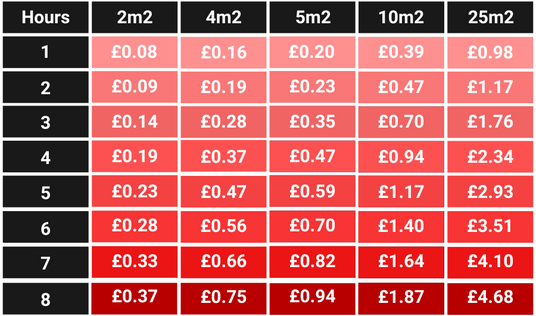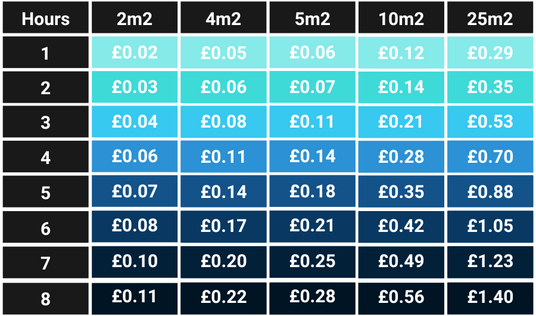
Underfloor Heating Installation Costs
The table provides a comprehensive overview of the estimated costs associated with the installation of two different types of underfloor heating systems in both new builds and older properties. The costs presented are based on an average 80m2 property.
Cost examples
Underfloor Heating Installation Cost for New Builds
Installing underfloor heating in a new build is cheaper than renovating an older property. This is because it’s easier to build in underfloor heating from the get go than it is to change the heating system in a property.
Depending on the type of system, installation costs between £2,300 to £6,500 on average in a new build property.
Regardless of whether the property is old or new, installing an electric underfloor heating system is cheaper vs a water system because the system is less complex to install.
For a 60m2 sized property and a contactor rate of £30, installing electric underfloor heating costs between £2,300 to £2,600. A wet system costs more than double, between £5,500 and £6,500, on average.
Underfloor Heating Installation Cost for Renovated House
It’s cheaper to install an electric system vs a water system when renovating a property. This is because it’s a less complex system to install, with fewer materials and reduced labour time. It also requires fewer changes to be made to the property.
Installation costs for renovating a property to include underfloor heating range between £4,000 to £9,000 on average, depending on the system type.
On an average property of 60m2, with a contractor rate of £30 per hour, installing electric underfloor heating can cost between £4,000 to £4,500. This includes the cost of materials and labour charges.
Within the same sized property, installing water underfloor heating is more expensive. On average, it can cost between £9,000 to fit wet underfloor heating in the UK.
Costs associated with getting underfloor heating
Technology
Before installing underfloor heating, it’s important to consider the maximum power required and what system is best for your property. More power is required for larger homes, open plan living spaces, and/or houses with less insulation.
For example, our ProWarm™ electric underfloor heating range comes in three different wattages: 100watt, 150watt and 200watt. The ProWarm 100W Underfloor Heating Mats are best suited to larger living spaces in a well-insulated home.
Whereas older properties, especially those with less insulation, require a higher wattage, like 150watt to 200watt. The more complex the technology used in the system is, the higher the installation and running costs of underfloor heating will be.
Labour Costs
Labour costs to install underfloor heating can vary depending on where you live in the UK. The costs provided in the table above use a rate of £30 per hour for labour charges, which is considered average.
However, labour costs can be higher if additional work is required. For example, if further insulation is required, like to the walls, doorways, or windows, labour costs will increase.
Type of Underfloor Heating
Wet Underfloor Heating System
A wet system uses water and central heating to heat a room. The installation involves fitting pipes under flooring that connect to a boiler or heat pump. The water is warmed via the boiler.
A wet underfloor heating system is also known as a:
- Water underfloor heating
- Warm water underfloor heating
- Gas underfloor heating
- Hydronic underfloor heating
While wet systems operate in a similar way to traditional radiators, they are significantly more efficient. This is because the water within the pipes doesn’t need to reach as high of a temperature to heat a room.
One of the main advantages of wet underfloor heating systems is that they are cheaper to run compared with electric systems (depending on the energy tariff).
They are also better suited to rooms that are used for longer periods, like kitchens and living rooms. This is because the floors stay warm for longer, even after the heating is turned off.
Wet systems can however be more costly to maintain, particularly if something goes wrong. They also take longer to heat a room (around two hours for larger spaces) compared with an electric system.
Electric Underfloor Heating System
Electric heating runs on electricity, so running costs are controlled by the electricity tariff in the property. Electric underfloor heating is installed by fitting heating mats or cables underneath floors that connect to the mains electricity supply.
An electric underfloor heating system is also commonly called a:
- Dry system
- Radiant system
A main advantage of electric systems is that they are cheaper to install. This is because the materials are cheaper and labour time is minimal (as the installation is far less complex).
Because electric systems have no moving parts to wear out and come with a lifetime warranty*, they are also unlikely to fail. Plus, should an issue occur, electric heating mats won’t cause water damage to flooring or ceilings like water systems will.

Electric Underfloor Heating Costs by Size
Running costs will always depend on many factors including the room size, the running time, as well as how well the room has been insulated; these figures are based on using our 10mm insulation boards.
The table aside provides an indication of how much underfloor heating costs to run per hour based on room size for electric underfloor heating.

Water Underfloor Heating Costs by Size
Our easy-to-understand table aside provides an indication of how much water underfloor heating costs to run based on the size of room and the hours it has run for.
Costs by room
Small Bathroom
Most small bathrooms, shower rooms, or ensuites in the UK are between 2m2 to 3m2 in size. To heat a small bathroom with an underfloor heating system, this can cost between 4 to 9p for two hours.
Medium-Sized Bathroom
A medium-sized bathroom or ensuite in the UK is between 4m2 and 5m2, sometimes larger. To heat a medium to large-sized bathroom with underfloor heating can range between 8p to 11p for two hours.
Medium-Sized Kitchen
Kitchens in newer properties (built past the year 2000) are generally sized around 13m2. Older properties built between the 50s and 80s have slightly larger kitchens, between 14m2 and 15m2 on average (source). To heat a medium-sized kitchen with underfloor heating, this can cost around 32por less for two hours.
Large Kitchen
Large or open-plan kitchens can vary in size, between 15m2 to 25m2+. Underfloor heating can be especially effective when installed in larger, open-plan areas compared with radiators. To heat a large kitchen with underfloor heating, this can cost between 32p to 54p for two hours.


